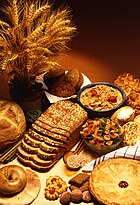スペルトコムギ
| スペルトコムギ | ||||||||||||||||||||||||||||||
|---|---|---|---|---|---|---|---|---|---|---|---|---|---|---|---|---|---|---|---|---|---|---|---|---|---|---|---|---|---|---|

| ||||||||||||||||||||||||||||||
| 分類(APG III) | ||||||||||||||||||||||||||||||
| ||||||||||||||||||||||||||||||
| 学名 | ||||||||||||||||||||||||||||||
| Triticum spelta L. | ||||||||||||||||||||||||||||||
| シノニム | ||||||||||||||||||||||||||||||
|
スペルトコムギ(スペルト小麦、学名: Triticum spelta)は、約7千年前に栽培されだした小麦の一種である。スペルト小麦は青銅器時代から中世にかけてヨーロッパの多くの地域で主食となっていた。現在では中央ヨーロッパやスペイン北部で遺存種として残っており、健康食品として市場を拡大しつつある。

進化
[編集]スペルトコムギ(AABBDDゲノム)は遺伝子解析によれば、自然発生的にエンマー小麦などの4倍体の栽培用小麦(AABBゲノム)と近東に自生しているタルホコムギ(DDゲノム)が交雑したものとされる[2]。9,000年前には中東で栽培が行われていた[3]。
遺伝的にはパンコムギ(AABBDDゲノム)とエンマーコムギの交雑によっても生じるが、この交雑までに4倍体の小麦とタルホコムギが交雑しなければならない。しかし、ヨーロッパではスペルト小麦の出現が遅く、パンコムギとエンマーコムギの交雑により生じた可能性がある。近年のDNA解析では、パンコムギとエンマーコムギの交雑によりヨーロッパでスペルト小麦が現れたことを裏付けている[4][5]しかし、完全にアジアとヨーロッパのスペルト小麦が別々の起源をもつか、近東に単一の起源をもつかはわかっていない[4][6]。
歴史
[編集]ギリシャ神話では、スペルト小麦は女神デーメーテールからギリシャ人への贈り物であった[7]。紀元前5千年紀のスペルト小麦の痕跡が南コーカサスや黒海北東岸で見つかっている。また、ヨーロッパではスペルト小麦に関する記録が多く残っている[8]。 中央ヨーロッパでは後期新石器時代(紀元前2500年 - 紀元前1700年頃)のスペルト小麦の痕跡が見つかっている[8]。青銅器時代にはヨーロッパ全土へと広まり、鉄器時代にはドイツ南部やスイス、紀元前500年ごろにはブリテン島で一般に栽培されていた[8][9]。
古代ローマにおいて結婚式において新郎と新婦がスペルト小麦のケーキを分かち合っていた[10]。また、古代ローマ人はスペルト小麦が炭水化物を多く含んでいることから「進軍の穀物」と呼んでいた[11]。
中世にはスイス、チロル地方、ドイツ、フランス北部、低地諸国南部で栽培されていた[12]。9世紀にはヨーロッパにおいて主要な穀物であった。これは殻があることから寒冷な地域にも適応し、貯蔵にも向いていたためであると考えられている[13]。
アメリカ合衆国には1890年代にもたらされた。20世紀にはいると、スペルト小麦を栽培していた農家のほとんどがパンコムギの栽培に切り替えた。20世紀終わりにかけて有機農業によって少ない肥料で栽培できるスペルト小麦が再び注目されるようになった[14]。21世紀初めから製パンやパスタ作り、フレーク作りにも用いられるようになった[15]。
栄養価
[編集]| 100 gあたりの栄養価 | |
|---|---|
| エネルギー | 1,415 kJ (338 kcal) |
|
70.19 g | |
| デンプン 正確性注意 | 53.92 g |
| 食物繊維 | 10.7 g |
|
2.43 g | |
| 多価不飽和 | 1.258 g |
|
14.57 g | |
| ビタミン | |
| チアミン (B1) |
(32%) 0.364 mg |
| リボフラビン (B2) |
(9%) 0.113 mg |
| ナイアシン (B3) |
(46%) 6.843 mg |
| ビタミンB6 |
(18%) 0.230 mg |
| 葉酸 (B9) |
(11%) 45 µg |
| ビタミンE |
(5%) 0.79 mg |
| ミネラル | |
| ナトリウム |
(1%) 8 mg |
| カリウム |
(8%) 388 mg |
| カルシウム |
(3%) 27 mg |
| マグネシウム |
(38%) 136 mg |
| リン |
(57%) 401 mg |
| 鉄分 |
(34%) 4.44 mg |
| 亜鉛 |
(35%) 3.28 mg |
| マンガン |
(143%) 3.0 mg |
| 他の成分 | |
| 水分 | 11.02 g |
|
| |
| |
| %はアメリカ合衆国における 成人栄養摂取目標 (RDI) の割合。 | |
スペルト小麦はグルテンを含んでおり製パンに適するが、セリアック病、非セリアック・グルテン過敏症、小麦アレルギーなどグルテン関連障害をもつ者には不適である[16][17]。冬小麦と比べるとグリアジン比率、グルテニン比率が高く、基質タンパク質の溶解性が高い[18][19]。
製品
[編集]
ドイツとオーストリアでは、スーパーマーケットでスペルト小麦粉が、スペルト小麦のパンとロールパン(Dinkelbrot)がパン屋で手に入る。熟していないスペルト小麦は乾燥させてグリュンケルンとして食される。
オランダの蒸留酒であるイェネーフェルはスペルト小麦を用いて蒸留している[20]。バイエルン州やベルギーでは時折スペルト小麦からビールを醸造している[21][22]。
脚注
[編集]- ^ The Plant List: A Working List of All Plant Species 11 May 2016閲覧。
- ^ JAN DVORAK; KARIN R. DEAL; MING-CHENG LUO; FRANK M. YOU; KEITH VON BORSTEL; HAMID DEHGHANI (2012-2-29). “The Origin of Spelt and Free-Threshing Hexaploid Wheat”. Journal of Heredity 103 (3).
- ^ “What is Spelt?”. sharphampark.com. 2021年10月9日閲覧。
- ^ a b Blatter, R.H.; Jacomet, S.; Schlumbaum, A. (January 2004). “About the Origin of European Spelt ( Triticum spelta L.): Allelic Differentiation of the HMW Glutenin B1-1 and A1-2 Subunit Genes”. Theoretical and Applied Genetics 108 (2): 360–367. doi:10.1007/s00122-003-1441-7. PMID 14564390.
- ^ De Oliveira, Romain; Rimbert, Hélène; Balfourier, François; Kitt, Jonathan; Dynomant, Emeric; Vrána, Jan; Doležel, Jaroslav; Cattonaro, Federica et al. (18 August 2020). “Structural Variations Affecting Genes and Transposable Elements of Chromosome 3B in Wheats”. Frontiers in Genetics 11: 891. doi:10.3389/fgene.2020.00891. PMC 7461782. PMID 33014014.
- ^ Ehsanzadeh, Parviz (1999). Agronomic and growth characteristics of spring spelt compared to common wheat (Doctoral thesis). University of Saskatchewan. hdl:10388/etd-10212004-001220. 2024年4月3日閲覧。
- ^ Harrison, Jane Ellen (5 September 1908). “Prolegomena to the study of Greek religion”. Cambridge [Eng.] : The University press. 2021年10月9日閲覧。
- ^ a b c Cubadda, Raimondo; Marconi, Emanuele (2002). Spelt Wheat in Pseudocereals and Less Common Cereals: Grain Properties and Utilization Potential (eds. Belton, Peter S.; Taylor, John R.N.). ISBN 9783540429395
- ^ Akeret, Ö. (2005). Plant Remains From a Bell Beaker Site in Switzerland, and the Beginnings of Triticum spelta (spelt) Cultivation in Europe. オリジナルの2012-12-27時点におけるアーカイブ。.
- ^ Chisholm, Hugh, ed. (1911). . Encyclopædia Britannica (英語). Vol. 7 (11th ed.). Cambridge University Press. p. 898.
- ^ “Future 50 Foods”. Knorr.com. 25 October 2020閲覧。
- ^ Bakels, Corrie C. (Dec 2005), "Crops produced in the southern Netherlands and northern France during the early medieval period: a comparison," Vegetation History and Archaeobotany, pp. 394-399
- ^ Newfield, Timothy P. (2013), "The Contours, Frequency and Causation of Subsistence Crises in Carolingian Europe (750-950 CE)" in Crisis Alimentarian en la Edad Media, Lleida, Spain: Universidad de Lleida, p. 170
- ^ Sugár, Eszter; Fodor, Nándor; Sándor, Renáta; Bónis, Péter; Vida, Gyula; Árendás, Tamás (27 November 2019). “Spelt Wheat: An Alternative for Sustainable Plant Production at Low N-Levels”. Sustainability 11 (23): 6726. doi:10.3390/su11236726.
- ^ Smithers, Rebecca (15 May 2014). “Spelt flour 'wonder grain' set for a price hike as supplies run low”. The Guardian, London, UK. 30 January 2017閲覧。
- ^ Tovoli F.; Masi C.; Guidetti E. , et al. (March 16, 2015). “Clinical and Diagnostic Aspects of Gluten Related Disorders”. World Journal of Clinical Cases 3 (3): 275–284. doi:10.12998/wjcc.v3.i3.275. PMC 4360499. PMID 25789300.
- ^ Wieser H. (2001). “Comparative Investigations of Gluten Proteins from Different Wheat Species”. European Food Research and Technology 213 (3): 183–186. doi:10.1007/s002170100365.
- ^ Schober, T.J., Bean, S.R., Kuhn, M. (2006). “Gluten Proteins from Spelt (Triticum aestivum ssp. spelta) Cultivars: A Rheological and Size-Exclusion High-Performance Liquid Chromatography Study” (pdf). Journal of Cereal Science 44 (2): 161–173. doi:10.1016/j.jcs.2006.05.007 21 November 2013閲覧。.
- ^ Kohajdová, Z., Karovičová, J. (2008). “Nutritional Value and Baking Applications of Spelt Wheat”. Acta Scientiarum Polonorum. Technologia Alimentaria. 7 (3): 5–14 21 November 2013閲覧。.
- ^ John N. Peragine (2010-11-30). The Complete Guide to Growing Your Own Hops, Malts, and Brewing Herbs. Atlantic Publishing Company. p. 128. ISBN 9781601383532 1 September 2012閲覧。
- ^ Dinkelbier Archived 2016-03-03 at the Wayback Machine., German Beer Institute, retrieved November 2009.
- ^ Den Mulder, beer from Huisbrouwerij Den Tseut in Oosteeklo, retrieved September 2013.

